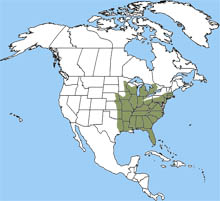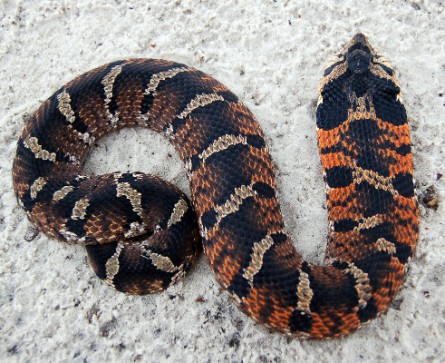Post by Ceratodromeus on Jan 6, 2016 0:08:28 GMT 5

Scientific classification
Kingdom: Animalia
Phylum: Chordata
Subphylum: Vertebrata
Class: Reptilia
Order: Squamata
Suborder: Serpentes
Family: Colubridae
Subfamily: Xenodontinae
Genus: Heterodon
Species: H. platirhinos
Description
This is a very variatable snake colorwise. Depending on locality, these snakes can range from a solid black, to multicolored (Green, brown, white, black), to animals that have a mottled black and red coloration. Some populations are a more "standard" white and brown coloration. The species is distinguishable from other species it is sympatric with via the upturned snout it possesses - which gives the snakes of the genus Heterodon their common name. It is a stout bodied snake, with a large, robustly proportioned head. Like the closely related Western Hognosed Snake (H. nasicus), it is mildly venomous{1}. The species ranges anywhere from 50-70cm(19.6-27.5in) in Snout-vent length{2}, though large individuals can measure 80+cm(31+in).

Geographic range
As the common name may suggest, this snake is endemic to the Eastern United States, and extends up into Canada as well. Studies conducted in New York and New Hampshire have shown that this species prefers sandy pine forests, and areas with low canopy cover{2}. Females prefer sandy terrain as it ideal for them to lay their eggs in.

Dietary habits
Regarded as a " extreme dietary specialist", the Eastern hognosed snake that consists almost exclusively on amphibians. In areas of this snakes where it is sympatric with Fowlers' Toad (Bufo Woodhousei fowleri), it commonly preys on it{3}. Salamanders have also been documented in the diet of this snake{4}, and This species also takes small rodents in captive settings.

Defensive behaviors
When threatened, this snake will either flatten its head in an attempt to make itself look larger(much like that of the Naja cobras), or it will "death feign"-- that is, roll onto their back with their tongue hanging limply from their jaws. This is a technique utilized by other members of the genus Heterodon to get potential predators to leave them alone.

Reproduction
Mating occurs in the Spring/ early summer, with males often trailing their female counterparts before and after copulation has ceased{5}. Females lay their eggs in sandy substrate, and incubation lasts anywhere from 49-63 days.{6} A large clutch of eggs can be as many as 43 eggs{2}.
References
{1} Young, Robert A. "Effects of Duvernoy's gland secretions from the eastern hognose snake, Heterodon platirhinos, on smooth muscle and neuromuscular junction." Toxicon 30.7 (1992): 775-779.
{2}Robson, Laura E. "The spatial ecology of Eastern Hognose Snakes (Heterodon platirhinos): habitat selection, home range size, and the effect of roads on movement patterns." (2011).
{3} PLUMMERI, MICHAEL V., and NATHAN E. MILlef. "Hognose Snakes (Heterodon platirhinos)."
{4}Trauth, Stanley E. "Vertebrate Prey ofSelected Arkansas Snakes." Proceedings Arkansas Academy of Science. Vol. 49. 1995.
{5}Plummer, Michael V., and Nathan E. Mills. "Observations on trailing and mating behaviors in hognose snakes (Heterodon platirhinos)." Journal of Herpetology (1996): 80-82.
{6} Cunnington, Glenn M., and Joseph E. Cebek. "Mating and nesting behavior of the eastern hognose snake (Heterodon platirhinos) in the northern portion of its range." The American midland naturalist 154.2 (2005): 474-478.


